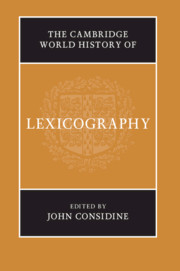Book contents
- The Cambridge World History of Lexicography
- The Cambridge World History of Lexicography
- Copyright page
- Contents
- Contributors
- Editor’s Acknowledgements
- Introduction
- Part I The Ancient World
- Part II The Pre-Modern World
- Part III The Modern World: Continuing Traditions
- 15 China from c. 1700
- 16 Japanese, Korean, and Vietnamese from c. 1800
- 17 Turkish and Persian from c. 1700
- 18 South Asia from c. 1750
- 19 Arabic from c. 1800
- 20 Modern Hebrew
- 21 The Slavic and Baltic Languages
- 22 The Germanic Languages Other than English from c. 1700
- 23 Standard Varieties of English from c. 1700
- 24 Regional Varieties of English
- 25 The Romance Languages from c. 1700
- Part IV The Modern World: Missionary and Subsequent Traditions
- Appendix 1 The Language Varieties
- Appendix 2 The Lexicographers
- Primary Sources
- Secondary Sources
- Index
23 - Standard Varieties of English from c. 1700
from Part III - The Modern World: Continuing Traditions
Published online by Cambridge University Press: 01 September 2019
- The Cambridge World History of Lexicography
- The Cambridge World History of Lexicography
- Copyright page
- Contents
- Contributors
- Editor’s Acknowledgements
- Introduction
- Part I The Ancient World
- Part II The Pre-Modern World
- Part III The Modern World: Continuing Traditions
- 15 China from c. 1700
- 16 Japanese, Korean, and Vietnamese from c. 1800
- 17 Turkish and Persian from c. 1700
- 18 South Asia from c. 1750
- 19 Arabic from c. 1800
- 20 Modern Hebrew
- 21 The Slavic and Baltic Languages
- 22 The Germanic Languages Other than English from c. 1700
- 23 Standard Varieties of English from c. 1700
- 24 Regional Varieties of English
- 25 The Romance Languages from c. 1700
- Part IV The Modern World: Missionary and Subsequent Traditions
- Appendix 1 The Language Varieties
- Appendix 2 The Lexicographers
- Primary Sources
- Secondary Sources
- Index
Summary
This chapter sets out a history of the main developments in the lexicography of English as a standard language since around 1700. In practice, this means focusing first on Samuel Johnson’s Dictionary of the English Language (1755), enormously influential on English-language lexicography well into the nineteenth century, and secondly on the Oxford English Dictionary (OED), similarly influential on subsequent publications, whether in its first edition (OED1, 1884–1928), its main twentieth-century Supplement, or its gradually emerging reincarnation in revised form online (OED3, 2000–). Many dictionaries play an important constitutive or subsidiary role in the story, however, ranging from the dictionaries preceding Johnson, through those for English-language learners of the late twentieth and early twenty-first centuries (most notably Cobuild, 1987), to those of non-English varieties of the standard such as Scots, Canadian, Australian, and others. This chapter discusses dictionaries produced in the UK and (to a lesser extent) the United States, reflecting the pervasive historical and cultural influence of England and the UK on English lexicography to date.
- Type
- Chapter
- Information
- The Cambridge World History of Lexicography , pp. 484 - 508Publisher: Cambridge University PressPrint publication year: 2019



